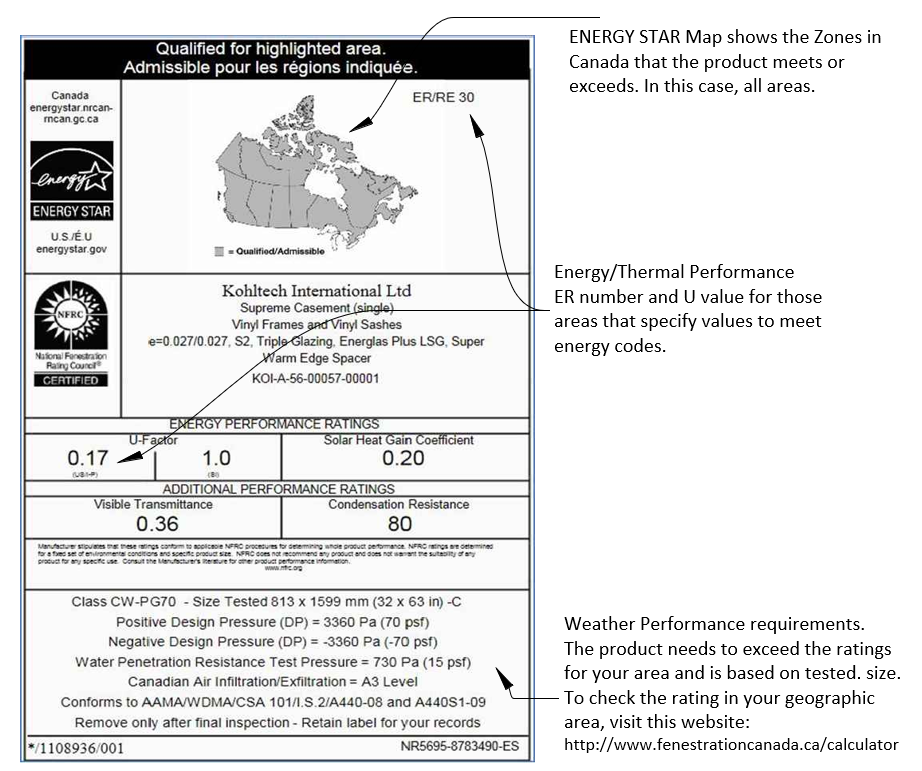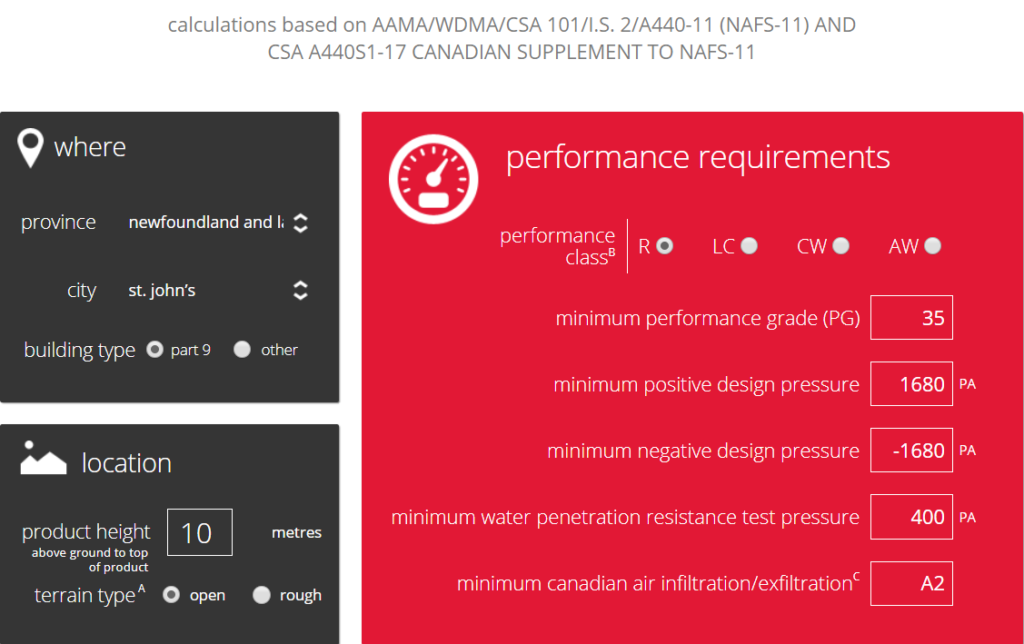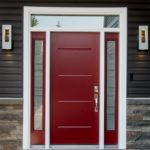National Building Code Summary for Windows and Doors
The new standard for the National Building Code requires all residential windows and doors to meet the North American Fenestration Standard (NAFS). This standard requires doors and windows to meet performance ratings based on certain criteria. The performance ratings outline the water infiltration, air infiltration and structural ability to withstand wind load.
The window and/or door must meet the requirements that include:
- Local location (location dictates wind, water and structural)
- Height from the ground
- The higher the location of the window or door the more wind pressure.
- The default is 10 meters (33 ft) and covers most residential housing.
- Terrain type; Open or closed.
- Closed terrain indicates that the structure is in a valley, subdivision, surrounded by trees or in a protected area from the wind and driving rain.
- Open terrain indicates that the structure is subject to higher winds such as no surrounding protection (top of a hill, exposed to a lake or ocean) and is subject to higher wind pressures.
The tabular information of ratings based on the above information is included in the National Building code but is cumbersome to use and not easily accessible so our national organization developed a Fenestration Calculator to assist with identifying the requirements. The website is http://www.fenestrationcanada.ca/calculator/a44os1-17
This example of the calculator is for Halifax.

The calculator spells out the specific criteria that the product must meet for the chosen location:
- Performance Class (R, LC, CW, AW)
- R – Single-family residential buildings
- LC- Low and mid-rise multi-family residential and light commercial buildings
- CW – Mid-rise multi-family residential and commercial office buildings
- AW- High-rise multi-family residential and commercial buildings
- Minimum Performance Grade (PG)
- Minimum positive design pressure
- Minimum negative design pressure
- Minimum Water Design Test Pressure, usually 15% of Min positive design pressure
- Air infiltration
Companies like Kohltech must have products tested to meet and exceed the performance criteria for the areas where their sell products. These products must be tested and certified by an independent testing authority and follow the labeling guidelines set out by the building code which include:
- You can only put a label on a product that has been tested.
- The window or door size must be the same or smaller than the size tested.
- Mullions (the joint between individual panes of glass or between window frames) must be tested and can only be labelled if they are equal to or smaller than the mullion and configuration tested as per the independent test reports.
The sample label below outlines the certified test results based on NAFS testing requirements. The NAFS label also shows the ENERGY STAR rating and Energy performance.

Performance Requirements – Structural, Water, and Air
The performance grade (PG) rating is designed to ensure the installed window or door has the structural capability to withstand the wind load based on exposure, height, and location as outlined by the NAFS standard of National Building Code. The structural pressures (positive and negative) are outlined on the product label and are typically in pascals (PA). The user needs to ensure the PG rating of the window and door exceeds the PG requirements of the building code as per the Fenestration Canada Calculator and the installed size must be the same or less than the tested size.
The Canadian Building code also states that the window and door must also meet and or exceed the driving rain conditions of the location and is indicated by the minimum water penetration resistance test pressure, usually in pascals (PA).
The window and door must also meet or exceed the minimum Canadian air infiltration/exfiltration of the code and is indicated by the A rating. A2 is the minimum rating in Canada.
In summary, the window or door product that is to be installed in a building in Canada must meet the NAFS requirements which states the window and door must be tested and labelled and meet or exceed the requirements of the physical location, exposure, height off the ground and size. It must always meet the structural PG rating but also has to meet the water and air ratings.
Examples to illustrate this:
Location: Pincher Creek, Alberta

| Size | Positive | Negative | Water | Air Rating | |||
| Style | Width | Height | PG Rating | Design Pressure | Design Pressure | Resistance | |
| (in) | (in) | (PA) | (PA) | (PA) | |||
| Casement | 36 | 72 | 55 | 2640 | -2640 | 730 | A3 |
| Casement | 30 | 48 | 70 | 3360 | -3360 | 730 | A3 |
| Dash 2 Casement | 72 | 72 | 30 | 1440 | -1440 | 730 | A3 |
| Glider | 72 | 48 | 30 | 1440 | 1440 | 330 | A3 |
Pincher Creek is a high wind area in Alberta and the requirements are minimum PG 45, 2160 for structural, 330 for water and A2 for air.
- The 36×72 Casement exceeds all of the requirements.
- The 30×48 Casement exceeds all of the requirements.
- The 72×72 Dash 2 casement does not meet the PG rating based on structural but does meet the water and air rating. In this case a smaller tested window may be used to achieve the required structural rating.
- The 72×48 glider does not meet the PG rating for structural but it does meet on water and air so a smaller tested window may be used to achieve the required structural rating.

| Size | Positive | Negative | Water | Air Rating | |||
| Style | Width | Height | PG Rating | Design Pressure | Design Pressure | Resistance | |
| (in) | (in) | (PA) | (PA) | (PA) | |||
| Casement | 36 | 72 | 55 | 2640 | -2640 | 730 | A3 |
| Casement | 30 | 48 | 70 | 3360 | -3360 | 730 | A3 |
| Dash 2 Casement | 72 | 72 | 30 | 1440 | -1440 | 730 | A3 |
| Glider | 72 | 48 | 30 | 1440 | 1440 | 330 | A3 |
St. John’s, Newfoundland is located in a wind and driving rain area and the requirements are minimum PG 35, 1680 for structural, 400 for water and A2 for air.
- The 36×72 Casement exceeds all of the requirements.
- The 30×48 Casement exceeds all of the requirements.
- The 72×72 Dash 2 casement does not meet the PG rating based on structural but does meet the water and air rating. In this case a smaller tested window may be used to achieve the required structural rating.
- The 72×48 glider does not meet the PG rating for structural or water but does meet on water air so a smaller or different style tested window may be used to achieve the required structural and water rating.
For Frequently Asked Questions regarding NAFS, please see our FAQ page.
Energy Performance. Energy Codes and ENERGY STAR
ENERGY STAR is a voluntary and well-known consumer standard. ENERGY STAR is based on tables and outlines the minimum U-value (rate of heat transfer, the inverse of R and Energy Rating (ER)) rating required by zone in Canada. The lower the U-value number, the slower it transfers heat from a warm area to a cold area. The ER value is calculated using a formula that balances a product’s U-value with its potential solar heat gain coefficient (SHGC) and its air tightness. The higher the number, the more energy efficient the product. ER is focused on solar heat gain which is not always popular as it may create too much heat on the south exposure and creates air conditioning conditions in some locations. You can meet ENERGY STAR on either U value or ER for these reasons.
Energy codes typically fall under provincial jurisdiction and are designed to ensure products meet the minimum code for each Province. The Energy Code ER and U-Value guidelines of ENERGY STAR.
It is important to note that Provincial Energy Codes are mandatory and products must meet or exceed local Energy Codes. Whereas ENERGY STAR is a voluntary program that consumers can use to select products that are of a higher energy-efficiency rating.
Typically, ENERGY STAR products are the same or higher performing in terms of energy-efficiency versus the energy code.
Look for the Label
Taking the Mystery out of Buying Windows and Doors
The 2010 National Building Code has a new standard for air, water and structural performance for Windows and Doors and this has been adopted in the building code for every Province. This new standard is called the North American Fenestration Standard and is commonly referred to as NAFS. The National Building Code now requires windows and doors to have a standardized label to prove the product meets the NAFS Building Code standard for their particular area.
Compliance
The air, water, structural, and energy performance requirements for windows and doors vary with climate and location. There are performance requirements for more than 600 locations across Canada included in the building code and NAFS standard. If installed products are found not to be in compliance or not properly labelled to prove they are in compliance this could lead to delays, added costs and, ultimately, the removal of non-compliant products, replaced with compliant ones. By working with your Kohltech window and door dealer, builders, renovators and contractors you can ensure that the products being installed meet all local requirements and are properly certified and labelled to prove they conform to the building code.
Energy Rating and ENERGY STAR
Several provinces have an Energy Code or have adopted section 9.36 of the National Building Code of Canada with minimum ratings for windows and doors. Kohltech designs products with energy performance in mind and has many product options available that meet or exceed the requirements of the various (regional) Energy Codes and the Building code. In addition, many of our products also meet the more stringent requirements of the optional ENERGY STAR program including almost 300 models that have been awarded ENERGY STAR’s coveted Most Efficient Designation for 2015. Kohltech incorporated energy performance data into their labelling and this includes the zone map for ENERGY STAR and the energy performance of the product (ER number and U value) in case your Province or area specifies a minimum ER number or maximum U value.
Ensure Your Products Comply – Look for the Labels
The simplest way to ensure that your products are compliant is to make sure your window and/or door has a label that includes Energy and Weather performance.
Kohltech has been testing, redesigning, upgrading and certifying their window and door systems for the past several years in order to prepare for these new codes and to provide you products that meet or exceed the energy and weather performance requirements.
The best time to address the performance requirement for windows and doors with your local building official is at the plan checking stage. Find out the local requirements and include this in your plans (Your Kohltech window and door expert can help with this):
Weather performance: http://fenestrationcanada.ca/calculator/a44os1-17
Energy Performance: Check to see if your Province has an energy code with specific U values or ER ratings.
4 Easy steps to meet the building code:
- Work with your Kohltech window and door supplier to make sure the products being supplied and installed are both building code and energy code compliant for your area. Different styles of window and doors have different product ratings and your Kohltech Window and Door expert can help you decide the best product for your area.
- Have a discussion with your Kohltech window and door suppliers to ensure the products are properly labeled for your area.
- Do not remove any labels prior to final inspection; building officials may require considerable documentation to prove compliance if the labels have been removed.
- Keep the window performance labels after removal and keep them in your homeowner care and maintenance guide package. This will ensure that the information on any further energy audits will be readily available.
Still Not Sure? Look for the NAFS label. Consult your Kohltech Windows & Entrance System dealer to assist you with making sure you will have the properly labeled window and door product for your area.
NAFS Approved label includes Energy Performance, ENERGY STAR Zones, and Weather Performance Ratings








